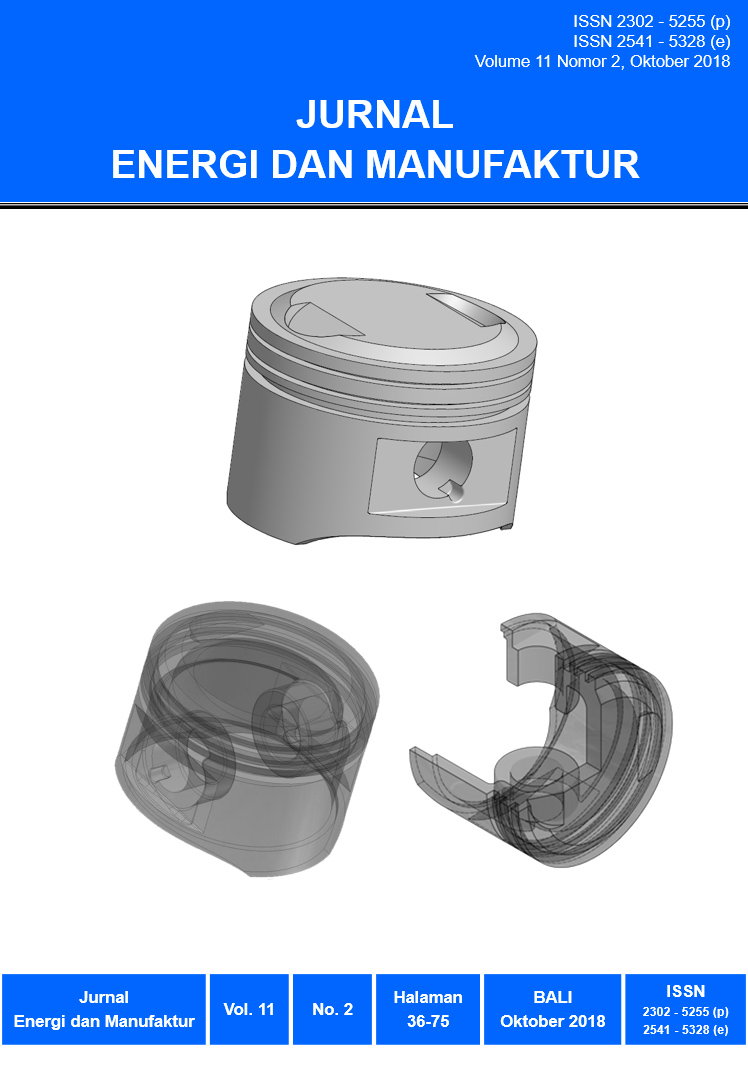Analisis CFD pada Geometri Backward-facing Step dengan variasi Bilangan Reynolds
Abstract
Sistem tata udara pada bidang perhotelan merupakan salah satu aspek penting untuk menunjang kenyamanan, yang pada daerah pariwisata seperti Bali dengan iklim tropis dilakukan dengan aplikasi pendingin udara (AC). Aliran udara pada hotel bertingkat biasa dibuat terpusat dan dialirkan ke tempat tujuan dengan menggunakan ducting dengan penampang segi empat. Menyesuaikan dengan denah yang ada, seringkali terdapat bagian ducting yang harus dibuat bertingkat pada titik datum yang sama (zona ekspansi). Geometri bertingkat ini dapat menghasilkan kerugian aliran karena pada zona ekspansi tersebut timbul aliran berputar (aliran resirkulasi). Pemahaman terhadap aliran berputar dapat dilakukan dengan lebih mudah, menarik dan berbiaya rendah dengan menggunakan geometri Backward-facing step (BFS). Pada penelitian ini, dilakukan analisis numerik melalui simulasi CFD terhadap aliran resirkulasi pada sebuah geometri backward-facing step, dengan panjang total (L) = 4050 mm, step height (h) = 41 mm, upstream height (H) = 81 mm, rasio ekspansi = 1.5, dan lebar (t) = 20h. Eksperimen dilakukan dengan fluida kerja asap. Untuk mendapatkan hasil yang lebih luas, eksperimen juga dilakukan pada 3 (tiga) variasi bilangan Reynolds: Re = 7.315,79; Re = 21.947,37; dan Re = 29.263,16. Simulasi CFD dilakukan secara 3 dimensi dengan menggunakan model turbulen RNG k-?, mesh jenis triangular dengan jumlah nodal sebanyak 36.806 nodal. Vorteks resirkulasi ditunjukkan melalui zona resirkulasi yang direpresentasikan oleh vektor kecepatan arah-x dan titik penyatuan (reattachment point) yang diukur dari zona resirkulasi. Hasil simulasi CFD menunjukkan bahwa vorteks resirkulasi timbul pada X/h = 29.2 hingga X/h = 35 untuk seluruh bilangan Reynolds uji yang direpresentasikan oleh vektor kecepatan arah-x, dimana Reynolds Re = 7.315,79 menghasilkan titik penyatuan pada X/h > 35 dari zona resirkulasi, lebih jauh dibandingkan dengan yang dicapai oleh bilangan Reynolds yang semakin besar
Air conditioning system is an important aspect in tourism industry that has become a priority sector in Bali, Indonesia. It’s tropical climate make the air conditioning system use for cooling system only (AC). The centralized air conditioning system in high rise building uses ducting system with rectangular cross-sectional area which often depends on a given blue print. Some specific area of the blue print may lead to adjustment of the ducting system, e.g. the gradual step of the ducting system. This gradual base of the ducting may cause additional consequences, a recirculation flow at the gradation area (the expansion zone). As already known, the recirculation flow leads to flow losses. This paper discuss an numerical analysis with CFD simulation of a backward-facing step (BFS) geometry. The BFS geometry used in this has total length (L) = 4050 mm, step height (h) = 41 mm, upstream height (H) = 81 mm, expansion ratio = 1.5, and width (t) = 20h. The CFD simulation conducted three dimensionaly with RNG k-? turbulence model, and 36.806 triangular nodes. Recirculation vortices represented by recirculation zone with x-velocity and reattachment point. The result of CFD simulation that is conducted to Reynolds number Re = 7.315,79; Re = 21.947,37; dan Re = 29.263,16 shows that recirculation vortices occur at X/h = 29,2 to X/h = 35 for tested Reynolds number. Reattachment point at Reynolds number of 7.315.79 occur at X/h > 35, which farther than that is achieved at larger Reynolds number.
Downloads
References
[2] H. Togun et al., “Thermal performance of nanofluid in ducts with double forward-facing steps,” J. Taiwan Inst. Chem. Eng., vol. 47, pp. 28–42, 2015.
[3] W. A. Xie and G. N. Xi, “Fluid flow and heat transfer characteristics of separation and reattachment flow over a backward-facing step,” Int. J. Refrig., vol. 74, pp. 175–187, 2017.
[4] F. Selimefendigil and H. F. �ztop, “Forced convection and thermal predictions of pulsating nanofluid flow over a backward facing step with a corrugated bottom wall,” Int. J. Heat Mass Transf., vol. 110, pp. 231–247, 2017.
[5] H. Iwai, K. Nakabe, and K. Suzuki, “Flow and heat transfer characteristics of backward-facing step laminar flow in a rectangular duct,” Int. J. Heat Mass Transf., vol. 43, no. 3, pp. 457–471, 2000.
[6] K. Sarker, “Computational Analysis of the Physics of Flow over Backward / Forward Facing Step,” vol. 11, no. 8, pp. 5549–5554, 2016.
[7] A. Kitoh, K. Sugawara, H. Yoshikawa, and T. Ota, “Expansion Ratio Effects on Three-Dimensional Separated Flow and Heat Transfer Around Backward-Facing Steps,” J. Heat Transfer, vol. 129, no. 9, p. 1141, 2007.
[8] A. Keating, U. Piomelli, K. Bremhorst, and S. Nešić, “Large-eddy simulation of heat transfer downstream of a backward-facing step,” J. Turbul., vol. 5, no. 04, pp. 1–27, 2004.
[9] M. S. Kostas, J; Soria, J; Chong, “A Study of a Backward Facing Step Flow at Two Reynolds Numbers,” in 14th Australian Fluid Mechanics Conference, 2001, pp. 609–612.
[10] N. Kasagi and A. Matsunaga, “3-D particle-tracking velocimetry measurement of turbulence statistics and energy budget in a backward-facing step flow (Kasa.pdf,” no. 1989, 1993.
[11] S. Darmawan, “LAPORAN AKHIR HIBAH RISET INTERNAL 2016 DIREKTORAT PENELITIAN DAN LAPORAN AKHIR HIBAH RISET INTERNAL 2016,” 2017.
[12] V. Yakhot and S. A. Orszag, “Renormalization group analysis of turbulence. I. Basic theory,” J. Sci. Comput., vol. 1, no. 1, pp. 3–51, 1986.
[13] S. Thangam and C. G. Speziale, “Turbulent Separated Flow past a Backward-Facing Step: a Critical Evaluation of Two-Equation Turbulence Models,” no. 91, p. 28, 1991.
[14] S. Thangam, “Ad-a240 683,” no. 91, 1991.
[15] S. Darmawan et al., “Turbulent flow analysis in auxiliary cross-flow runner of a Proto X-3 Bioenergy micro gas turbine using RNG K-ε turbulence model,” ARPN J. Eng. Appl. Sci., vol. 10, no. 16, 2015.
[16] S. Darmawan, “EXPERIMENTAL STUDY OF SMOKE OVER A BACKWARD-FACING STEP GEOMETRY,” in The 3rd International Conference on Engineering of Tarumanagara (ICET) 2017, 2017.
[17] Y. T. Chen, J. H. Nie, B. F. Armaly, and H. T. Hsieh, “Turbulent separated convection flow adjacent to backward-facing step-effects of step height,” Int. J. Heat Mass Transf., vol. 49, no. 19–20, pp. 3670–3680, 2006.

This work is licensed under a Creative Commons Attribution-NonCommercial-ShareAlike 4.0 International License.









